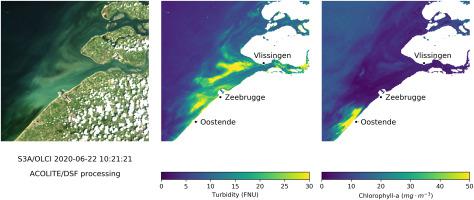Remote Sensing of Environment ( IF 11.1 ) Pub Date : 2021-02-12 , DOI: 10.1016/j.rse.2021.112284 Quinten Vanhellemont , Kevin Ruddick

|
The performance of different atmospheric correction algorithms for the Ocean and Land Colour Instrument (OLCI) on board of Sentinel-3 (S3) is evaluated for retrieval of water-leaving radiance reflectance, and derived parameters chlorophyll-a concentration and turbidity in turbid coastal waters in the Belgian Coastal Zone (BCZ). This is performed using in situ measurements from an autonomous pan-and-tilt hyperspectral radiometer system (PANTHYR). The PANTHYR provides validation data for any satellite band between 400 and 900 nm, with the deployment in the BCZ of particular interest due to the wide range of observed Near-InfraRed (NIR) reflectance. The Dark Spectrum Fitting (DSF) atmospheric correction algorithm is adapted for S3/OLCI processing in ACOLITE, and its performance and that of 5 other processing algorithms (L2-WFR, POLYMER, C2RCC, SeaDAS, and SeaDAS-ALT) is compared to the in situ measured reflectances. Water turbidities across the matchups in the Belgian Coastal Zone are about 20–100 FNU, and the overall performance is best for ACOLITE and L2-WFR, with the former providing lowest relative (Mean Absolute Relative Difference, MARD 7–27%) and absolute errors (Mean Average Difference, MAD -0.002, Root Mean Squared Difference, RMSD 0.01–0.016) in the bands between 442 and 681 nm. L2-WFR provides the lowest errors at longer NIR wavelengths (754–885 nm). The algorithms that assume a water reflectance model, i.e. POLYMER and C2RCC, are at present not very suitable for processing imagery over the turbid Belgian coastal waters, with especially the latter introducing problems in the 665 and 709 nm bands, and hence the chlorophyll-a and turbidity retrievals. This may be caused by their internal model and/or training dataset not being well adapted to the waters encountered in the BCZ. The 1020 nm band is used most frequently by ACOLITE/DSF for the estimation of the atmospheric path reflectance (67% of matchups), indicating its usefulness for turbid water atmospheric correction. Turbidity retrieval using a single band algorithm showed good performance for L2-WFR and ACOLITE compared to PANTHYR for e.g. the 709 nm band (MARD 15 and 17%), where their reflectances were also very close to the in situ observations (MARD 11%). For the retrieval of chlorophyll-a, all methods except C2RCC gave similar performance, due to the RedEdge band-ratio algorithm being robust to typical spectrally flat atmospheric correction errors. C2RCC does not retain the spectral relationship in the Red and RedEdge bands, and hence its chlorophyll-a concentration retrieval is not at all reliable in Belgian coastal waters. L2-WFR and ACOLITE show similar performance compared to in situ radiometry, but due to the assumption of spatially consistent aerosols, ACOLITE provides less noisy products. With the superior performance of ACOLITE in the 490–681 nm wavelength range, and smoother output products, it can be recommended for processing of S3/OLCI data in turbid waters similar to those encountered in the BCZ. The ACOLITE processor for OLCI and the in situ matchup dataset used here are made available under an open source license.
中文翻译:

大气校正Sentinel-3 / OLCI数据,以绘制比利时混浊沿海水域中悬浮颗粒物和叶绿素a浓度的图
对Sentinel-3(S3)上海洋和陆地颜色仪器(OLCI)的不同大气校正算法的性能进行了评估,以获取离水辐射反射率,并推导了浑浊的沿海水域中叶绿素a的浓度和浊度的参数在比利时沿海地区(BCZ)。这是使用自动云台高光谱辐射计系统(PANTHYR)的原位测量来执行的。PANTHYR可提供400到900 nm之间任何卫星波段的验证数据,由于观察到的近红外(NIR)反射率范围广,在BCZ中的部署尤为重要。暗光谱拟合(DSF)大气校正算法适用于ACOLITE中的S3 / OLCI处理,其性能以及其他5种处理算法(L2-WFR,聚合物,C2RCC,SeaDAS,和SeaDAS-ALT)与现场测量的反射率进行比较。比利时沿海地区对决中的水浊度约为20–100 FNU,对于ACOLITE和L2-WFR,总体性能最佳,前者的相对浊度最低(平均绝对相对差异,MARD为7–27%),绝对值为442和681 nm之间的波段中的误差(均值平均差,MAD -0.002,均方根差,RMSD 0.01-0.016)。L2-WFR在更长的NIR波长(754–885 nm)下提供最低的误差。假设采用水反射模型的算法(即POLYMER和C2RCC)目前不适用于处理浑浊的比利时沿海水域的图像,尤其是后者会在665和709 nm波段引入问题,因此叶绿素a和浊度检索。这可能是由于其内部模型和/或训练数据集无法很好地适应BCZ中遇到的水域所致。1020 nm波段是ACOLITE / DSF最常使用的波段,用于估算大气路径反射率(占对比例的67%),表明其可用于混浊水的大气校正。与PANTHYR相比,使用单波段算法进行浊度反演对L2-WFR和ACOLITE表现出良好的性能,例如709 nm波段(MARD 15和17%),其反射率也非常接近原位观测值(MARD 11%) 。对于叶绿素a的检索,由于RedEdge谱带比算法对典型的频谱平坦的大气校正误差具有鲁棒性,因此除C2RCC以外的所有方法均具有相似的性能。C2RCC不会保留Red和RedEdge频段中的光谱关系,因此在比利时沿海水域中,其叶绿素a浓度的获取根本不可靠。与原位辐射测定法相比,L2-WFR和ACOLITE表现出相似的性能,但是由于假设了空间上一致的气溶胶,ACOLITE提供的噪音产品更少。凭借ACOLITE在490–681 nm波长范围内的卓越性能以及更平滑的输出产品,可建议在类似于BCZ的混浊水中处理S3 / OLCI数据。根据开放源代码许可,此处提供了用于OLCI的ACOLITE处理器和原位匹配数据集。ACOLITE提供的噪音较少。凭借ACOLITE在490–681 nm波长范围内的卓越性能以及更平滑的输出产品,可建议在类似于BCZ的混浊水中处理S3 / OLCI数据。根据开放源代码许可,此处提供了用于OLCI的ACOLITE处理器和原位匹配数据集。ACOLITE提供的噪音较少。凭借ACOLITE在490–681 nm波长范围内的卓越性能以及更平滑的输出产品,可建议在类似于BCZ的混浊水中处理S3 / OLCI数据。根据开放源代码许可,此处提供了用于OLCI的ACOLITE处理器和原位匹配数据集。











































 京公网安备 11010802027423号
京公网安备 11010802027423号